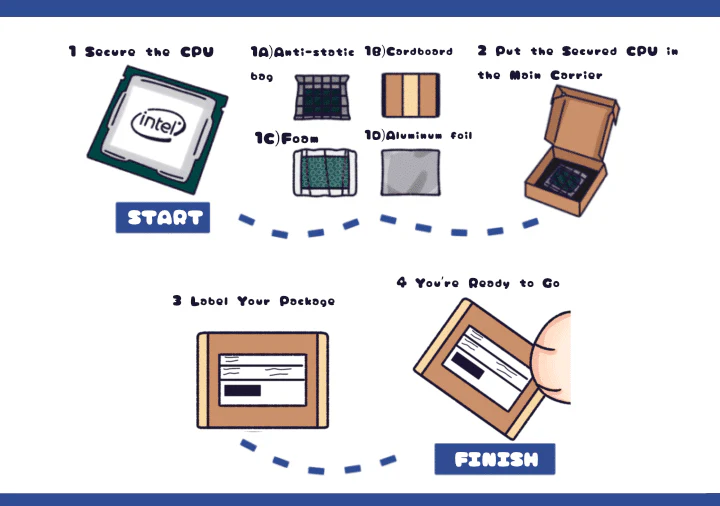Shipping a CPU requires meticulous attention to detail to ensure it reaches its destination safely and securely. Using an anti-static bag is crucial for protecting sensitive electronic components from electrostatic discharge (ESD). Additionally, selecting reliable packaging materials and a trustworthy shipping service further enhances the protection of your CPU during transit.
“To ship a CPU with a static bag, first place the CPU in an anti-static bag, ensuring it’s securely closed. Then, pack the bag in a sturdy box with cushioning material to prevent movement and damage during transit.”
I this article, We Will discuss “ How To Ship A CPU With A Static Bag”
Table of Contents
Why Use a Static Bag:

Protection Against Electrostatic Discharge:
Electrostatic discharge occurs when there is a sudden flow of electricity between two objects caused by contact, friction, or induction. This discharge can seriously damage the delicate circuitry of CPUs and other electronic components. A static bag is designed specifically to protect against this type of damage by preventing the buildup of static electricity.
Types of Static Bags:
There are two main types of static bags: pink (or translucent) and black (or conductive). Pink static bags are typically made from polyethylene and are designed to dissipate static electricity safely, making them suitable for many electronic components. In contrast, black conductive bags offer superior protection against electrostatic discharge and are recommended for high-value items like CPUs, ensuring maximum safety during shipping.
Also Read: How To Use Virtual CPU Real CPU – A Comprehensive Guide For Businesses!
Pink Anti-Static Bags:
These are typically made from polyethylene and are designed to dissipate static electricity safely. While they are effective for many components, they provide limited protection against ESD. Pink anti-static bags are a popular choice for packaging electronic components because they are lightweight and cost-effective. However, for critical items like CPUs, it’s advisable to use black conductive bags for enhanced protection against electrostatic discharge.
Black Conductive Bags:
These bags are made from materials that conduct electricity and are more effective in preventing ESD. They are generally recommended for high-value items, such as CPUs, as they offer superior protection. Additionally, black conductive bags are often used in professional environments where electronic components require the highest level of safeguarding against static electricity.
Materials Needed:
Before you begin the shipping process, gather the following materials:
- Anti-static bag: Ensure it is the right size for your CPU, and consider using a black conductive bag for optimal protection.
- Sturdy shipping box: A corrugated box provides excellent protection against physical damage.
- Cushioning material: Bubble wrap, packing peanuts, foam, or even crumpled paper can absorb shocks and vibrations.
- Tape: Use strong packing tape to securely seal the box.
- Labeling materials: Shipping label, return address label, and any necessary documentation (like a customs declaration for international shipments).
Step-by-Step Guide to Shipping a CPU:

Prepare the CPU:
Before packaging your CPU, make sure to follow these guidelines:
- Handle with Care: Always hold the CPU by the edges to avoid touching the pins or contacts. Oils from your fingers can also lead to corrosion over time.
- Clean the CPU: If there is any dust or debris on the CPU, gently clean it using a soft brush or compressed air. Ensure it is completely dry before placing it in the anti-static bag.
Place the CPU in the Anti-Static Bag:
Carefully insert the CPU into the anti-static bag. Make sure the bag is securely closed. You can use a zip-lock style bag or seal it with tape if necessary. This step is crucial as it protects the CPU from ESD during transit. Ensure that the CPU is positioned correctly within the bag to prevent any pressure on the pins or contacts, which could lead to damage.
Add Cushioning Material to the Shipping Box:
Choose a sturdy shipping box that is appropriate for the size of your CPU. Line the bottom of the box with cushioning material, ensuring there’s a solid layer to absorb shock and vibrations. The cushioning should extend up to the sides of the box, offering full support. Additionally, using a combination of cushioning materials, such as bubble wrap and packing peanuts, can provide extra protection against impacts during shipping.
Also Read: How Much RPM For CPU Fan – How Much Do You Really Need!
Insert the CPU:
Gently place the CPU (inside the anti-static bag) into the box. Ensure it fits snugly but does not press against the sides of the box. If there are any gaps, use more cushioning material to fill them, preventing movement during shipping. Make sure to position the CPU in a way that minimizes any potential contact with the box walls, further reducing the risk of damage during transit.
Add More Cushioning:
Once the CPU is in place, add additional cushioning material on top of the CPU. This extra layer helps protect the component from impacts during shipping. Ensure that the CPU is entirely surrounded by cushioning material. This additional cushioning also helps to stabilize the CPU within the box, preventing it from shifting or bouncing around during transport
Seal the Box:
Close the box securely and use packing tape to seal all openings. Make sure there are no gaps or loose edges. Use multiple strips of tape to reinforce the seams, especially if the box is heavy. It’s important to ensure that the tape is applied firmly to create a strong seal that can withstand the rigors of shipping. Additionally, consider marking any seams or edges with extra tape for added security, especially if the box contains fragile items.
Label the Package:
Clearly label the box with the recipient’s address, your return address, and any necessary shipping information. If you are shipping internationally, include any required customs documentation. For fragile items like CPUs, consider marking the box as “FRAGILE” to alert postal workers to handle it with care.
Choose a Reliable Shipping Service:
- Reputation: Choose a reputable courier that specializes in shipping electronics.
- Tracking Options: Opt for a service that offers tracking so you can monitor the package’s journey.
- Insurance: For high-value items like CPUs, consider purchasing shipping insurance to protect against loss or damage.
Additional Tips for Safe Shipping:

Use Original Packaging:
If you have the original packaging that came with the CPU, use it for shipping. Manufacturers often design their boxes to provide optimal protection. The original packaging is specifically engineered to safeguard the CPU from shocks and vibrations, making it an ideal choice for shipping. Furthermore, using the original packaging can help ensure that the CPU fits snugly and securely, minimizing the risk of damage during transit.
Avoid Extreme Weather Conditions:
If possible, avoid shipping during extreme weather conditions, as heat or moisture can damage electronic components. Extreme heat can cause thermal expansion and potential damage to the CPU, while excessive moisture can lead to corrosion and short-circuiting. By choosing a suitable time for shipping, you can further protect the integrity of your CPU and ensure it arrives in perfect working condition.
Also Read: Can CPU Run Without Thermal Paste – Is Thermal Paste Essential For CPUs!
Double-Boxing:
For extra protection, consider double-boxing. Place the first box (with the CPU inside) into a larger box filled with cushioning material. This extra layer can provide additional protection against impact.
Double-boxing also helps to absorb shocks from any external forces, reducing the risk of damage during transit. Furthermore, it provides an added layer of security in case the outer box is compromised, ensuring that the inner packaging remains intact.
Test Before Shipping:
If the CPU was previously in use, consider testing it before shipping. This ensures that it is in working condition and helps to avoid disputes regarding its functionality upon arrival. Testing the CPU prior to shipping not only confirms its operational status but also gives you a chance to check for any physical damage or defects. This proactive step can save you time and money by preventing potential issues with returns or claims after delivery.
FAQ’s
Here are five FAQs with short answers related to shipping a CPU with a static bag:
1. Why is it important to use a static bag when shipping a CPU?
Using a static bag protects the CPU from electrostatic discharge (ESD), which can damage the sensitive electronic components during transit.
2. What materials do I need to ship a CPU safely?
You will need an anti-static bag, a sturdy shipping box, cushioning material (like bubble wrap or packing peanuts), strong tape, and labeling materials.
3. How should I pack the CPU in the box?
Place the CPU in an anti-static bag, then cushion it with packing material in a sturdy box, ensuring it’s snug and secured to prevent movement during shipping.
4. Should I label the package as fragile?
Yes, labeling the package as “FRAGILE” can help ensure that postal workers handle it with extra care during transit.
5. What shipping options are best for sending a CPU?
Choose a reputable shipping service that offers tracking and insurance to protect against loss or damage during transport.
Conclusion
In conclusion, shipping a CPU with a static bag is essential for protecting it from electrostatic discharge and physical damage. By following the outlined steps—carefully packing the CPU in an anti-static bag and using cushioning materials—you can ensure its safe arrival. Proper packaging not only safeguards your investment but also provides peace of mind during the shipping process.

